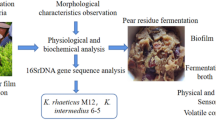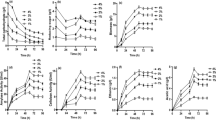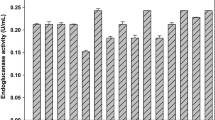Abstract
To improve cassava starch extraction by wet milling, solid-state fermentation of ground roots using cellulolytic-type alkaliphilic Bacilli spp., Bacillus akibai, B. cellulosilyticus and B. hemicellulosilyticus was investigated. Enzyme assay and scanning electron microscopy indicated that Bacillus spp. production of extracellular cellulase and polygalacturonase caused the formation of micropores through the root parenchyma cell walls and exposed the embedded cellulosic network. Gas chromatography data of the cell wall constituent sugars remaining after fermentation and Fourier transform infrared data indicated that the Bacillus treatments reduced the levels of pectin and, hemicellulose and to lesser extent cellulose. Wide-angle X-ray scattering data indicated that the Bacillus spp. cell wall degrading enzymes had partially hydrolysed the amorphous fractions of the cell wall polysaccharides. All the Bacillus spp. treatments improved starch extraction by 17–23% compared to fermentation with endogenous microflora. B. cellulosilyticus was most effective in disintegration of large root particles and as result, released marginally the most starch, probably due to it having the highest cellulase activity. Solid-state fermentation using cellulolytic-type Bacillus spp. is, therefore, promising to technology to improve the efficiency of cassava wet milling cell wall disintegration and consequent starch yield without use of commercial cell wall degrading enzymes or polluting chemicals.




Similar content being viewed by others
Abbreviations
- CWM:
-
Cell wall material
- EM:
-
Endogenous microflora
- MRD:
-
Maximum recovery diluent
- WAXS:
-
Wide-angle X-ray scattering spectroscopy
References
Parmar, A., Sturm, B., & Hensel, O. (2017). Crops that feed the world: production and improvement of cassava for food, feed, and industrial uses. Food Security, 9(5), 907–927.
Halley, P. J., & Avérous, L. (2014). Starch polymers: from genetic engineering to green application. San Diego: Elsevier (Chapter 3).
Saengchan, K., Nopharatana, M., Lerdlattaporn, R., & Songkasiri, W. (2015). Enhancement of starch-pulp separation in centrifugal-filtration process: effects of particle size and variety of cassava root on free starch granule separation. Food Bioproducts Processing, 95, 208–217.
Sriroth, K., Piyachomkwan, K., Wanlapatit, S., & Oates, C. G. (2000). Cassava starch technology: the Thai experience. Starch-Stärke, 52, 439–449.
Ray, R. C., & Sivakumar, P. S. (2009). Traditional and novel fermented foods and beverages from tropical root and tuber crops: review. International Journal of Food Science and Technology, 44, 1073–1087.
Ngea, G. L. N., Guillon, F., Ngang, J. J. E., Bonnin, E., Bouchet, B., & Saulnier, L. (2016). Modification of cell wall polysaccharides during retting of cassava roots. Food Chemistry, 213, 402–409.
Adetunji, A. I., du Clou, H., Walford, S. N., & Taylor, J. R. N. (2016). Complementary effects of cell wall degrading enzymes together with lactic acid fermentation on cassava tuber cell wall breakdown. Industial Crops and Products, 90, 110–117.
Padonou, S. W., Nielsen, D. S., Akissoe, N. H., Hounhouigan, J. D., Nago, M. C., & Jakobsen, M. (2010). Development of starter culture for improved processing of Lafun, an African fermented cassava food product. Journal of Applied Microbiology, 109, 402–1410.
Horikoshi, K. (1999). Alkaliphiles: some applications of their products for biotechnology. Microbiology and Molecular Biology Reviews, 63, 735–750.
Nogi, Y., Takami, H., & Horikoshi, K. (2005). Characterization of alkaliphilic Bacillus strains used in industry: proposal of five novel species. International Journal of Systematic and Evolutionary Microbiology, 55(Pt 6), 2309–2315.
Fujinami, S., & Fujisawa, M. (2010). Industrial applications of alkaliphiles and their enzymes–past, present and future. Environmental Technology, 31, 845–856.
Odoch, M., Buys, E. M., & Taylor, J. R. N. (2017). Mechanism of cassava tuber cell wall weakening by dilute sodium hydroxide steeping. Food Chemistry, 228, 338–347.
Gessesse, A., & Mamo, G. (1999). High-level xylanase production by an alkaliphilic Bacillus sp. by using solid state fermentation. Enzyme and Microbial Technology, 25, 68–72.
Amoa-Awua, W. K. A., & Jakobsen, M. (1995). The role of Bacillus species in the fermentation of cassava. Journal of Applied Microbiology, 79, 250–256.
Kumar, L., Kumar, D., Nagar, S., Gupta, R., Garg, N., Kuhad, R. C., & Gupta, V. K. (2014). Modulation of xylanase production from alkaliphilic Bacillus pumilis VLK-1 through process optimization and temperature shift operation. 3 Biotech, 4, 345–356.
Salvador, L. D., Suganuma, T., Kitahara, K., Tanoue, H., & Ichiki, M. (2000). Monosaccharide composition of sweetpotato fiber and cell wall polysaccharides from sweetpotato, cassava, and potato analyzed by the high-performance anion exchange chromatography with pulsed amperometric detection method. Journal of Agricultural and Food Chemistry, 48, 3448–3454.
Ramírez-Tapias, Y. A., Rivero, C. W., Britos, C. N., & Trelles, J. A. (2015). Alkaline and thermostable polygalacturonase from Streptomyces halstedii ATCC 10897 with applications in waste waters. Biocatalysis and Agricultural Biotechnology, 4, 221–228.
AACC. (2000). Approved methods of the American Association of Cereal Chemists (10th ed.). St. Paul: AACC (method 44-15A moisture—Air-oven).
Wokadala, O. C., Ray, S. S., & Emmambux, M. N. (2012). Occurrence of amylose–lipid complexes in teff and maize starch biphasic pastes. Carbohydrate Polymers, 90, 616–622.
Horikoshi, K. (1996). Alkaliphiles-from an industrial point of view. FEMS Microbiology Reviews, 18, 259–270.
Nyanga-Koumou, A. P., Ouoba, L. I. I., Kobawila, S. C., & Louembe, D. (2012). Response mechanisms of lactic acid bacteria to alkaline environments: a review. Critical Reviews in Microbiology, 38, 185–190.
Jayani, R. S., Shukla, S. K., & Gupta, R. (2010). Screening of bacterial strains for polygalacturonase activity: its production by Bacillus sphaericus (MTCC 7542). Enzyme Research, 306785.
Mead, D., Drinkwater, C., & Brumm, P. J. (2013). Genomic and enzymatic results show Bacillus cellulosilyticus uses a novel set of LPXTA carbohydrases to hydrolyze polysaccharides. PLoS One, 8(e), 61131.
Staack, L., Della Pia, E. A., Jørgensen, B., Petersson, D., & Pedersen, N. R. (2019). Cassava cell wall characterization and degradation by a multicomponent NSP-targeting enzyme (NSPase). Scientific Reports, 9, 10150.
Figueiredo, P. G., Moraes-Dallaqua, M. A. D., Bicudo, S. J., Tanamati, F. Y., & Aguiar, E. B. (2015). Development of tuberous cassava roots under different tillage systems: descriptive anatomy. Plant Production Science, 18, 241–245.
Hoeger, I. C., Nair, S. S., Ragauskas, A. J., Deng, Y., Rojas, O. J., & Zhu, J. Y. (2013). Mechanical deconstruction of lignocellulose cell walls and their enzymatic saccharification. Cellulose, 20, 807–818.
Wang, Q. Q., Zhu, J. Y., Gleisner, R., Kuster, T. A., Baxa, U., & McNeil, S. E. (2012). Morphological development of cellulose fibrils of a bleached eucalyptus pulp by mechanical fibrillation. Cellulose, 19, 1631–1643.
Cheng, J., Lin, R., Ding, L., Song, W., Li, Y., Zhou, J., & Cen, K. (2015). Fermentative hydrogen and methane cogeneration from cassava residues: effect of pretreatment on structural characterization and fermentation performance. Bioresource Technology, 179, 407–413.
Szymanska-Chargot, M., & Zdunek, A. (2013). Use of FT-IR spectra and PCA to the bulk characterization of cell wall residues of fruits and vegetables along a fraction process. Food Biophysics, 8(1), 29–42.
Park, S., Baker, J. O., Himmel, M. E., Parilla, P. A., & Johnson, D. K. (2010). Cellulose crystallinity index: measurement techniques and their impact on interpreting cellulase performance. Biotechnology for Biofuels, 3, 1–10.
Leite, A. L. M. P., Zanon, C. D., & Menegalli, F. C. (2017). Isolation and characterization of cellulose nanofibers from cassava root bagasse and peelings. Carbohydrate Polymers, 157, 962–970.
Chen, W., Yu, H., Liu, Y., Chen, P., Zhang, M., & Hai, Y. (2011). Individualization of cellulose nanofibers from wood using high-intensity ultrasonication combined with chemical pretreatments. Carbohydrate Polymers, 83, 1804–1811.
Funding
This work was supported by the International Centre for Development Oriented Research in Agriculture [grant number GU 145879-56] and a University of Pretoria Institutional Research Theme bursary.
Author information
Authors and Affiliations
Corresponding author
Ethics declarations
Conflict of Interest
The authors declare that they have no conflict of interest.
Additional information
Publisher’s Note
Springer Nature remains neutral with regard to jurisdictional claims in published maps and institutional affiliations.
Rights and permissions
About this article
Cite this article
Odoch, M., Buys, E.M. & Taylor, J.R.N. Solid-State Fermentation of Cassava Roots Using Cellulolytic-Type Alkaliphilic Bacillus spp. Cultures to Modify the Cell Walls and Assist Starch Release. Appl Biochem Biotechnol 191, 1395–1410 (2020). https://doi.org/10.1007/s12010-020-03286-x
Received:
Accepted:
Published:
Issue Date:
DOI: https://doi.org/10.1007/s12010-020-03286-x




